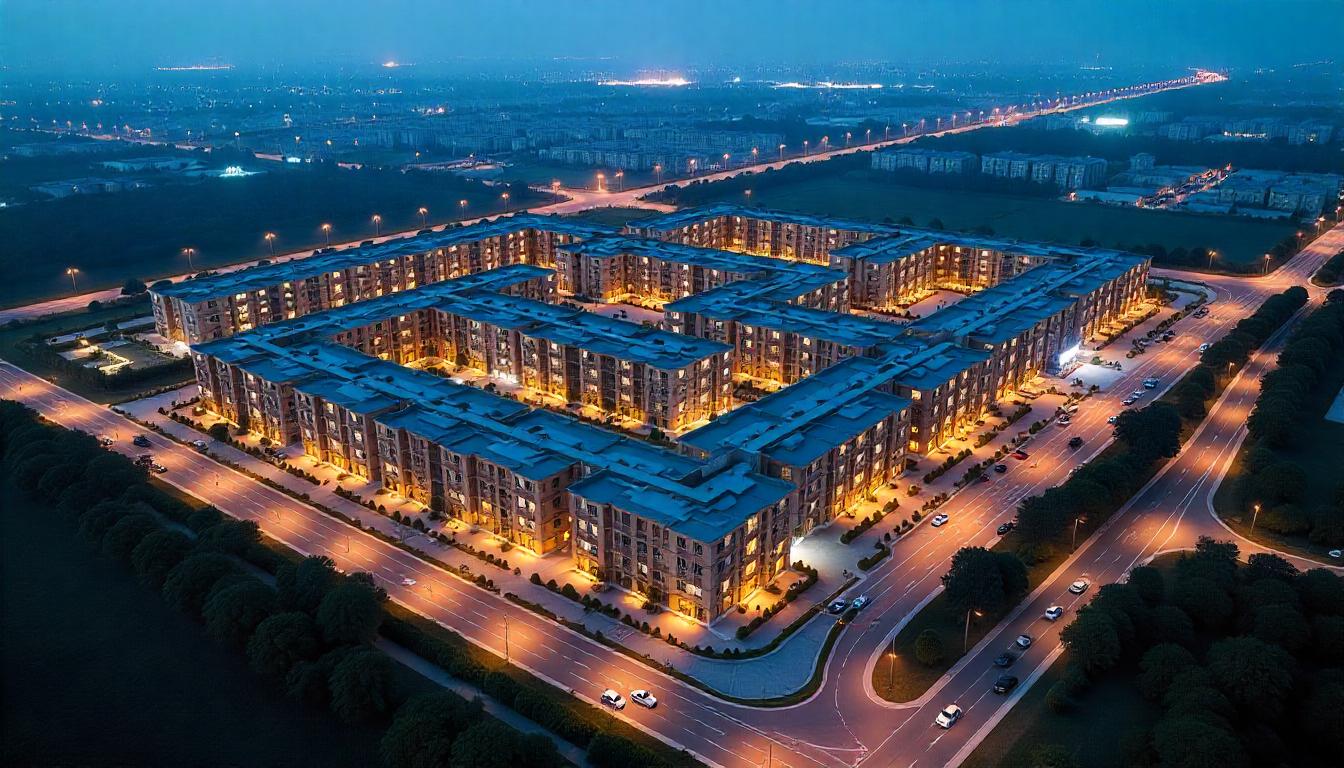
Blog
We keep you up to date on the most recent real estate news and events.
The Process of Developing a Modern Township: A Glimpse Inside
The Rise of Integrated Townships in India
India is urbanising at a breathtaking pace. By 2036, over 600 million people, nearly 40% of the nation’s population, are projected to live in urban areas, according to the MoHUA Urban Projections. This seismic shift is reshaping the real estate landscape, with integrated townships emerging as a solution to the challenges of unplanned urban sprawl. Unlike standalone housing societies, townships are self-contained ecosystems that blend residential, commercial, institutional, and recreational spaces into cohesive communities.
Projects like Magarpatta City in Pune, GIFT City in Gujarat, and Trident Hills in Panchkula exemplify how townships are redefining suburban landscapes. These developments are not merely about constructing homes but about creating vibrant micro-cities that prioritise connectivity, sustainability, and quality of life.
So, what does it take to bring such a township to life? Let’s dive in.
Land Acquisition and Location Strategy
The journey begins with land, often the most challenging piece of the puzzle. In India, land acquisition is governed by the Right to Fair Compensation and Transparency in Land Acquisition, Rehabilitation and Resettlement Act, 2013. This law mandates fair compensation, social impact assessments, and consent from at least 70% of affected families for public-private projects. Acquiring large, contiguous parcels—typically 100–1,000 acres—is essential for integrated townships, but it’s fraught with complexities, including title disputes and local opposition.
Location is paramount. Developers focus on areas with strategic advantages such as highways, metro access, and upcoming economic hubs. For example, Trident Hills in Panchkula benefits from its position along the Chandigarh–Delhi highway. Nearby, Zirakpur saw a 26.67% YoY rise in property prices in early 2025 due to improved connectivity and township developments (PropertyWala). Greater Noida, too, continues to see high appreciation, backed by metro links and the upcoming Jewar Airport. Developers also analyse zoning regulations, ensuring the land is designated for mixed-use or residential development, and engage legal experts to navigate state-specific land laws.
Community engagement is critical. Successful developers, like those behind Magarpatta, involve local stakeholders early, offering them stakes in the project to ensure buy-in. This collaborative approach not only mitigates resistance but also aligns the township’s vision with local aspirations.
Township Planning and Urban Design
With land secured, master planning transforms vision into reality. This phase brings together architects, urban planners, landscape designers, and sustainability experts to craft a blueprint that balances functionality, aesthetics, and resilience. The goal is to create a township that feels like a living community, not a concrete jungle.
Master plans divide the township into zones: residential (apartments, villas, plotted developments), commercial (offices, retail hubs), institutional (schools, hospitals), and recreational (parks, sports facilities). Walkability is a priority—think pedestrian-friendly pathways, cycle tracks, and green corridors. For example, Lavasa, India’s first planned hill city, prioritises car-free zones and scenic walkways, enhancing resident well-being.
Sustainability is woven into the design. Planners incorporate rainwater harvesting, solar-powered lighting, and energy-efficient layouts. The Indian Green Building Council (IGBC) reports that such designs can reduce energy consumption by 30–50% compared to conventional projects. Scalability is also key—master plans account for future population growth, ensuring the township can evolve without losing its charm.
Technology plays a growing role. Developers use Geographic Information Systems (GIS) and Building Information Modelling (BIM) to optimise land use and infrastructure placement. For instance, GIFT City’s master plan leverages smart city technologies, including real-time traffic monitoring and automated waste management, setting a benchmark for modern townships.
Infrastructure and Utilities: The Invisible Backbone
A township’s success rests on its infrastructure—the unseen systems that power daily life. Robust road networks, efficient drainage, sewage treatment plants, and reliable power grids form the backbone. High-speed fibre connectivity is non-negotiable, with 5G-enabled townships offering seamless digital integration.
Water management is a cornerstone of sustainable townships. Rainwater harvesting systems, sewage treatment plants, and water recycling facilities ensure self-sufficiency. According to the Green Rating for Integrated Habitat Assessment (GRIHA), green-rated townships can reduce water consumption by up to 40%. Solar street lighting, EV charging stations, and smart waste segregation further enhance sustainability, aligning with IGBC and LEED standards.
Connectivity is equally critical. Developers ensure proximity to public transport like metro stations or expressways and design internal roads to minimise congestion. The Greater Bengaluru Integrated Township, approved in January 2025, exemplifies this, with planned metro connectivity and access to the Bengaluru-Mysuru expressway. These systems, though invisible to residents, are meticulously planned to ensure a seamless living experience.
Navigating the Regulatory Maze
Building a township requires navigating a complex web of regulations. In India, developers must secure approvals from multiple bodies, including the Real Estate Regulatory Authority (RERA), local development authorities, and environmental agencies. Established under the Real Estate (Regulation and Development) Act, 2016, RERA mandates project registration, transparent timelines, and regular buyer updates.
As of early 2025, PropEquity reports that approximately 143,000 projects—comprising 1.11 crore housing units—have been registered across 20 state RERAs since 2017. This extensive registration trend underscores RERA’s broad reach and growing importance in promoting accountability and consumer protection in township development.
Environmental clearances are equally rigorous. Developers must comply with the Ministry of Environment, Forest and Climate Change guidelines, securing No Objection Certificates (NOCs) for water usage, waste management, and construction impacts. The government’s Ease of Doing Business initiative has streamlined approvals, reducing timelines from years to 12–24 months in progressive states like Maharashtra and Gujarat. For example, Maharashtra’s 2024 redevelopment rules simplified high-rise permissions and reduced bank guarantee requirements, accelerating township projects.
Compliance with the National Building Code (NBC) and local Development Control Regulations (DCR) is mandatory. Developers often hire specialised consultants to manage this process, ensuring no regulatory stone is left unturned. Delays, though reduced, remain a challenge, particularly in states with bureaucratic bottlenecks.
Green Compliance and Sustainable Design
Sustainability is a defining feature of modern townships, driven by buyer demand and regulatory mandates. As of mid‑2024, approximately 50% of new premium residential launches feature at least one green building element such as rainwater harvesting or solar rooftop systems (JLL India analysis).
IGBC-registered green projects have demonstrated substantial operational savings—for instance, over 15,000 MWh of annual energy savings and 45,000 kL of water savings per million square feet—translating to energy and water reductions often in the 30–50% range. . Trident Hills, for instance, integrates EV charging stations and dedicated green zones, catering to eco-conscious buyers.
Water and waste management are critical. Rainwater harvesting systems collect monsoon runoff, while sewage treatment plants recycle water for landscaping. Smart waste segregation, including composting units, minimises landfill dependency. These features not only reduce environmental impact but also lower operational costs, making townships attractive to cost-conscious buyers.
Amenities and Community Building
What makes a township more than a housing project? Its amenities. Modern townships are designed as “live-work-play” ecosystems, offering:
- Education and Healthcare
Integrated township developments increasingly feature on-site schools and clinics, offering immense convenience. Families value the proximity to quality education and healthcare, ensuring children and elderly family members have easy access without long commutes. - Retail and Workspaces
Many townships now include retail outlets and co-working zones, enabling residents to shop, dine, and work within walking distance. This not only reduces daily travel time but also builds vibrant, mixed-use micro-communities. - Recreation and Wellness
Well-designed communal spaces such as parks, sports courts, yoga decks, walking trails, and amphitheatres help foster healthier living. These amenities provide both physical and mental well-being benefits, aligning with the growing wellness-oriented expectations of modern homebuyers. - Soft Infrastructure
Beyond physical infrastructure, township living now emphasises curated community experiences. Features like 24/7 security, resident mobile apps, and events such as farmers’ markets, workshops, and seasonal festivals contribute to a strong sense of belonging and neighbourly engagement.
These amenities create a holistic living experience, appealing to families, professionals, and retirees, ensuring the residents feel connected and valued.
Phased Construction and Launch Strategy
Township development is a long-term endeavour, often spanning 5–15 years. To manage costs and ensure quality, developers adopt a phased approach. Phase 1 might focus on residential units or plotted developments, generating early revenue to fund subsequent phases like commercial or institutional zones. This strategy also allows developers to test market demand and refine later phases.
Buyers benefit from phased launches. Ready-to-move units appeal to those seeking immediate occupancy, while under-construction properties attract investors looking for cost savings. A 2023 ANAROCK report found that 41% of units sold in Q1 2023 across India’s top seven cities were fresh launches, reflecting strong demand for early-phase investments (ANAROCK).
Sales strategies are data-driven. Developers leverage digital marketing, virtual tours, and partnerships with firms like JLL or CBRE to reach buyers. Plotted developments are marketed to investors seeking customisation, while high-rise towers target urban professionals. RERA-compliant transparency, such as clear timelines and escrow accounts, builds trust, ensuring projects like Trident Hills attract both domestic and NRI buyers.
Townships as Value Creators for Micro-Markets
Integrated townships are true economic catalysts, reshaping suburban micro-markets. Zirakpur, adjacent to Chandigarh, posted an impressive 26.67% year-on-year increase in residential prices as of early 2025, driven by enhanced connectivity, airport proximity, and township infrastructure expansion. These developments attract ancillary businesses, retail, hospitality, schools, creating jobs and boosting local economies.
GIFT City’s impact on Ahmedabad is a case in point. Its financial hub status has spurred real estate demand in surrounding suburbs, with residential prices rising 15% year-on-year in 2024 (JLL India). Similarly, the Greater Bengaluru Integrated Township is poised to elevate Ramanagara’s status as a commercial and residential hotspot. This “rurbanisation” trend—blending rural charm with urban amenities—is making Tier-2 and Tier-3 cities viable alternatives to congested metros.
Integrated townships generate large-scale employment across phases—construction alone accounts for millions of jobs nationwide, while post-development operations support sectors like retail, education, and facility management. According to Knight Frank India, the real estate sector is projected to employ over 100 million people by 2030, with township projects playing a pivotal role in this surge.
(Business Standard)
Conclusion: Building Futures, Not Just Homes
Building a township in India is as much an art as it is a science. It takes years of planning, policy compliance, design thinking, and human empathy. But when done right, it becomes more than a housing cluster, it becomes a micro-city where lives flourish.
As India’s urbanisation deepens, such planned, sustainable, and inclusive communities are not just welcome, they are essential.
For developers and buyers alike, modern townships offer something truly rare in today’s fast world: the promise of permanence, peace, and purposeful living.